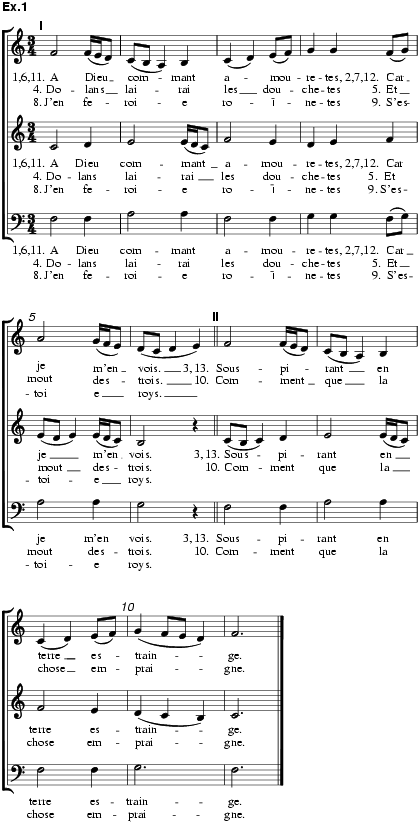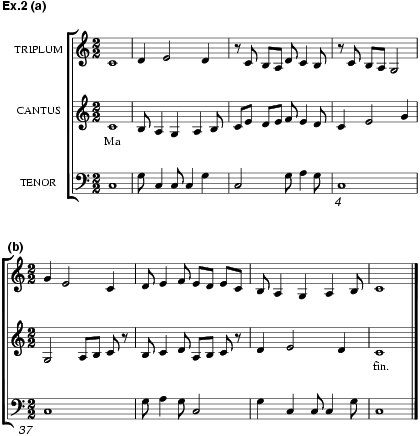
One of the three formes fixes (the others are the ballade and the virelai) that dominated French song and poetry in the 14th and 15th centuries. Unlike the ballade and the virelai, the rondeau had taken on its definitive structure by the early 13th century, when it was already a dance-song form of importance. At that stage it was known as ronde, rondet, rondel and rondelet (English ‘roundelay’), derived from the Latin forms rotundettum or rotundellum, diminutives meaning ‘circular’; this is generally taken to imply circular motion in the dances for which such pieces were originally sung.
The earliest known Old French rondeaux are found among the courtly and popular songs interpolated into the Roman de Guillaume de Dole by its author, Jean Renart (c1210/c1228). There are 16 in all, with varied metres and rhyme schemes and frequent ‘irregularities’ not to be found later in the rondeau’s history. Fundamentally, however, they all conform to a six-line type with music on the pattern I–I–I–II–I–II. A typical example, no.6, reads:
Aaliz
main se leva,
Bon jor ait qui mon cuer a!
Biau se vesti et para,
Desoz l’aunoi.
Bon jor ait qui mon cuer a!
N’est pas o moi.
Structurally this amounts to: I(a7) I(A7) I(a7) II(b4) I(A7) II(B4). The essential features are the presence of a final refrain which occupies the entire two-section melody, and the anticipation of the first part of this refrain in the second line. At the earliest stage variations often existed between the exact phraseology of the refrain and its anticipation, but later the anticipation became exact. Rondeaux of the six-line type are also to be found within the Lai d’Aristote by Henri d’Andeli. The next stage was to introduce the refrain at the opening of the composition as well, resulting in the overall musical form that was to remain the basis of the rondeau thereafter: I–II–I–I–I–II–I–II. The resultant eight-line type is the most common in the late 13th century and the 14th. Numerous examples of it, together with subsequent extensions, are again interpolated into narrative works such as Cleomadès by Adenet le Roi, the Roman du Castelain de Couci by Jakemes, Meliacin by Girart d’Amiens, the Roman de Fauvel by Gervais de Bus, and other scattered sources, quite apart from rondeaux forming part of the lyric output of known poet-musicians such as Adam de la Halle (whose 14 three-part settings in conductus style are the first polyphonic examples), Guillaume d’Amiens and Jehannot de l’Escurel, at the turn of the century.
The emergence of the refrain at the opening of the composition invites a comparison with virelai form and, indeed, has led some distinguished musicologists, especially Gennrich, to contrive complicated interconnections between the histories of the two forms. Others doubt the necessity for this and see them as entirely distinct. A vital differentiating factor is the particular importance acquired by the rondeau refrain, since its performance, though it may be only two lines long, entails the use of the whole melody, not simply part of it. This may well be the reason why rondeau refrains took on a life of their own and were often inserted into other songs, motets, romances and many miscellaneous literary works. Some 13th-century motets use an entire rondeau as one of the voice parts or as the fundamental tenor, which occasionally makes possible the reconstruction of a piece found elsewhere without music. Others, known as motets entés (‘grafted’ motets), use simply a rondeau refrain in one voice, but with considerable new textual and musical material interpolated between its original opening and closing lines. An excellent example of this is the treatment accorded to Adam de la Halle’s rondeau A Dieu commant amouretes (ex.1) in his motet A Dieu commant amouretes/Aucun se sont loé d’amours/Super te. Rondeau refrains, particularly in the 13th century, often seem to have been common property, and likewise certain phrases such as ‘Main se leva bele Aaliz’, ‘C’est tot là gieus’, ‘Là jus, desouz l’olive’ recur in sources apparently otherwise unconnected with each other. The example by Adam de la Halle is a 13-line type, and this is merely one of a number of possible extensions made simply by setting varying numbers of lines of text to the two underlying music sections, the pattern of which never changes.Table 1 shows typical possibilities.

|
table 1 |
|
|||||||
|
|
|
|||||||
|
|
|
|
|
|
|
|
|
|
|
Type |
I |
II |
I |
I |
I |
II |
I |
II |
|
8-line |
A |
B |
a |
A |
a |
b |
A |
B |
|
11-line |
A |
AB |
a |
A |
a |
ab |
A |
AB |
|
13-line |
AB |
B |
ab |
AB |
ab |
b |
AB |
B |
|
16-line |
AB |
BA |
ab |
AB |
ab |
ba |
AB |
BA |
|
21-line |
ABB |
BA |
abb |
ABB |
abb |
ba |
ABB |
BA |
|
|
|
|
|
|
|
|
|
|
|
|
|
|||||||
The rhyme and metre may vary. In the 13th and early 14th centuries the eight-, 11- and 13-line types are frequent and often use mixed metres. From Machaut onwards the eight- and 16-line types dominate, with the 21-line type becoming popular in the 15th century; mixed metres are rare in musical rondeau settings, though they may be encountered more often in unset verse (as, for example, in Christine de Pizan, who also promoted the use of shortened refrains).
Machaut’s 22 rondeaux are all polyphonic, for solo voice and one, two or three accompanying untexted lines. Some, such as Doulz viaire gracieus, are very brief musically (12 bars) and comparable in this respect with the earlier type; others, such as Tant doucement, are more extended (52 bars) and make much use of long melismatic decoration on single syllables, a common feature of contemporary ballades. The idea of circular motion implied in the word ‘rondeau’, long after it had become dissociated from the dance, appealed to the medieval mind in more ways than one, and Machaut provided a particularly fine example of ingenuity in this respect in his three-part rondeau Ma fin est mon commencement/Et mon commencement ma fin (F-Pn fr.22546; fig.1). Here the music illustrates the text, for at its close it has indeed returned to its beginning: section II of the instrumental tenor is the exact retrograde of its section I; the cantus section II is the retrograde of the instrumental triplum section I; and the triplum section II is the retrograde of the cantus section I. Ex.2 demonstrates this by giving the first four and the last four bars. A further, graphic example of the ‘circular’ rondeau idea is given in the early 15th century by Baude Cordier, whose canonic rondeau Tout par compas suy composés (F-CH 564;fig.2) is notated in circular form; his rondeau Belle, bonne, sage, with an equally imaginative notation in heart shape, appears in the same source.

The rondeau text, like that of most ballades and virelais, was usually concerned with courtly love, though the treatment of this theme was generally rather lighter than in the ballade, given the rondeau’s relative brevity. In one special area, however, the rondeau became widely used for a different purpose, namely in religious drama. Few religious rondeaux have survived with musical settings, but two or more texts are contained in each of the 40 14th-century Miracles de Nostre Dame, written and performed by the Goldsmiths’ Guild in Paris, and are normally sung by two or three voices as angels escort Our Lady to and from paradise. It seems likely that these texts, which structurally seem to belong more to the early 14th century, were contrafacta of pre-existing secular rondeaux and thus used existing music, with a simple substitution of religious for amorous sentiments. In this way the religious rondeau continued the 13th-century tradition of the chanson pieuse. In the great 15th-century French Passion cycles, by, for example, Arnoul Greban and Jean Michel, the rondeau, with much other incidental music, continued to be most important, even extending to cacophonous devils’ songs, and it also became a characteristic feature, in secular guise once more, of the 15th-century farce.
The 15th century was the true heyday of the rondeau, when it completely dominated all rival lyric forms. (For a detailed discussion of the relative popularity of rondeau, ballade and virelai in the 14th and 15th centuries seeVirelai.) Hundreds were composed with music, and hundreds more without. Of the most famous early 15th-century musicians, Du Fay left 59 and Binchois 47; many more remain by lesser figures such as Baude Cordier, Césaris, Haucourt, Lebertoul, Johannes Le Grant and Malbecque. Of the rondeaux written by non-musician poets the most important are by Christine de Pizan, Alain Chartier and Charles d’Orléans. Following the divorce between poets and musicians largely brought about by the great intricacy of late 14th-century musical style, it became more common than previously for musicians to set texts written by some poet other than themselves. A good and characteristic example is Binchois’ setting of Chartier’s rondeau Triste plaisir et douleureuse joie. Ex.3 gives the opening of this and demonstrates the characteristic instrumental prelude before the entry of the voice in bar 5. The style is mellifluous, simple but extremely touching and perfectly suited to the sentiments of the text.

The increasing appearance in this repertory of vocal writing with texts provided for all parts, reminiscent of Adam de la Halle but probably under Italian influence, together with ever-increasing use of imitation, point forward to important stylistic features of the chanson in the late 15th century and the 16th.
See also Ouvert. For bibliography see Chanson.
NIGEL WILKINS